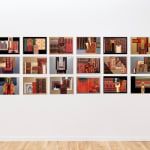Hazem Harb Italian-Palestinian, b. 1980
Stitching unity, 2024
Handmade collage on fine art paper.
32 x 45 cm
12 5/8 x 17 3/4 in
18 works
12 5/8 x 17 3/4 in
18 works
Further images
-
(View a larger image of thumbnail 1
)

-
(View a larger image of thumbnail 2
)

-
(View a larger image of thumbnail 3
)

-
(View a larger image of thumbnail 4
)

-
(View a larger image of thumbnail 5
)

-
(View a larger image of thumbnail 6
)

-
(View a larger image of thumbnail 7
)

-
(View a larger image of thumbnail 8
)

-
(View a larger image of thumbnail 9
)

-
(View a larger image of thumbnail 10
)

-
(View a larger image of thumbnail 11
)

-
(View a larger image of thumbnail 12
)

-
(View a larger image of thumbnail 13
)

-
(View a larger image of thumbnail 14
)

-
(View a larger image of thumbnail 15
)

-
(View a larger image of thumbnail 16
)

-
(View a larger image of thumbnail 17
)

-
(View a larger image of thumbnail 18
)

-
(View a larger image of thumbnail 19
)

Literature
By bringing the forgotten and marginalized to the fore, artists have the power to wrest the writing of history from the victors. Palestinian artist Hazem Harb is one such case. His photographic collages gather the fragments of Palestine's pre-Nakba history and reformulate them into works that explore memory, power, and heritage, to question who gets to write history, in what manner, and for whom.By refashioning and recasting the physical photograph, Harb highlights the medium as a malleable and potentially faulty reminder of the past and, more broadly, the imperfect nature of memory itself. He questions the process of recording history by exposing the ways in which it can be manipulated and encourages us to participate in its reworking by reflecting out images in his work. Through the many media he interweaves, Harb conveys the complexities of memory and longing that define the intractable state of Palestinians without resorting to overwrought symbolism. In doing so, Harb opens the work up to deeper reflections on the very nature of remembering, power, and politics of space.

























